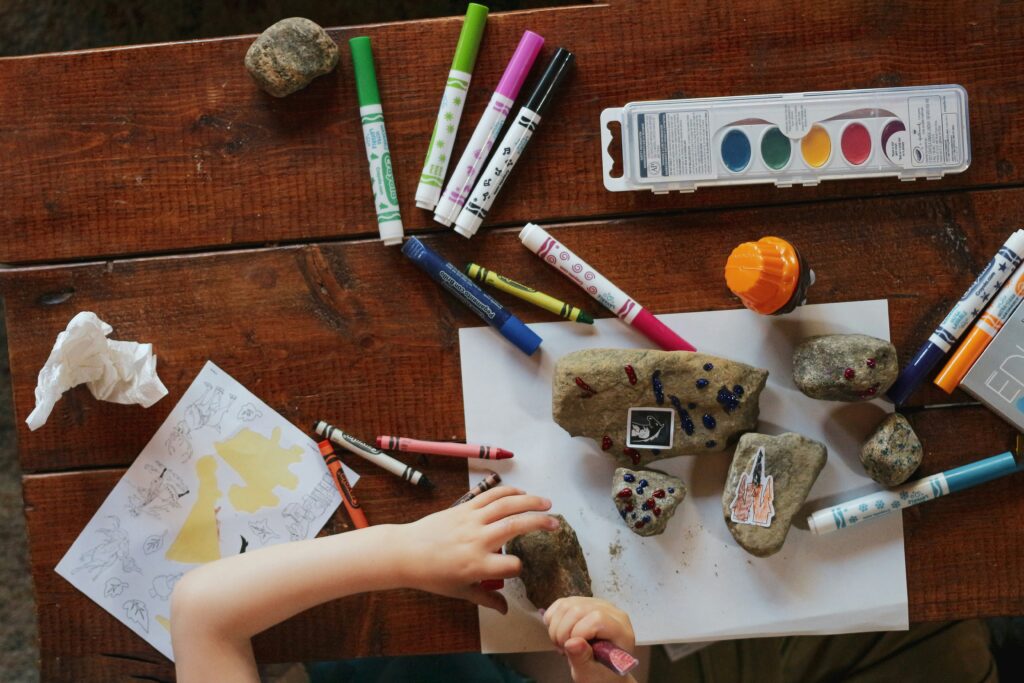Many of us have fond memories of pre-K and elementary school filled with excitement and play. This is because children are naturally curious, and elementary teachers typically found ways to nurture that curiosity. However, a research study revealed that the amount of playtime and the availability of play spaces in kindergarten classes significantly decreased between 1998 and 2010 as the focus shifted toward academic testing. This shift in the education world is causing more and more kids to dislike school from as early as pre-K.
One of the most important steps you can take in your child’s education is to keep learning fun. By incorporating learning and play, you’re showing your child that their curiosity is to be encouraged and explored. This will lead to a greater enjoyment of the learning process and allow your child to build a foundation for learning at an early age. In our podcast this week, we spoke about the value of making learning fun, and in this post, I’ll expand on some of those ideas regarding keeping the learning experience enjoyable and engaging for children from preschool through early elementary school.
The Value of Play-Based Learning
Play-based learning is one of the best ways to support children as they grow because it gives them a natural way to learn about the world. Research shows that when kids play, they’re developing important skills that build a strong foundation for learning. Through play, children explore new worlds, expand their imagination, and solve all sorts of problems all while having fun.
Avoiding High Expectations and Pressure
In today’s society, there can be a lot of pressure to push young children toward early academic milestones. When children are expected to meet strict academic milestones too early, it can create a lot of stress and a sense of failure that can lessen their love of learning. Research shows that children benefit more from hands-on, fun learning when they’re little. Incorporating play allows kids to learn at their own pace without the stress of traditional lessons. For example, kids can explore math through simple counting games or block-building instead of memorizing numbers, which makes learning feel less like a chore and more like playtime. By allowing children to learn at their own pace and follow their interests, parents and educators create a space for genuine curiosity and intrinsic motivation to grow.
Creating Positive Associations with Learning
Starting with positive, playful learning experiences helps children build confidence and excitement about school and new ideas. Picture this: your child is playing in a sandbox, building a sandcastle. They’re experimenting with different shapes and structures, which teaches them cause and effect while still enjoying the process of creating something. When kids enjoy learning, they’re more likely to approach challenges with curiosity.
Long-Term Benefits
The benefits of play-based learning go beyond early childhood. Research from the American Academy of Pediatrics emphasizes that children who engage in play-based learning show improved executive function skills, including memory, the ability to focus, and flexible thinking. By making learning fun and engaging, parents and educators can help kids develop a love for learning that will last them a lifetime.
It’s the gift that keeps on giving because prioritizing play as part of early learning helps children grow into confident, curious learners who see learning as something enjoyable and meaningful.
Developing Social and Emotional Skills
Play-based learning is a really important way for children to build social and emotional skills. Through fun activities, children learn valuable lessons about teamwork, patience, and empathy – all while having a blast with their friends. These skills are vital for forming healthy relationships as they grow, and playing is the perfect way to learn them.
Tackling Teamwork
One of the coolest things about play-based learning is how it encourages teamwork. When kids work together on activities, like building a fort or playing a game, they get to practice communicating and collaborating. Think about a group of children trying to build a fort; they share their ideas on materials and configuration and figure out how to work together. This kind of play teaches them to listen, express their thoughts, and find common ground. It might seem like a small thing to us, but when they’re tackling these challenges together, they’re developing teamwork skills and building a sense of community.
Promoting Patience
Patience is another key social skill that kids learn through play. Many games require them to wait their turn or follow certain rules, which helps them practice self-control. A lot of kids play board games, and as they take turns, they learn that patience is important for having fun. This experience helps prepare them for social situations later on and teaches them that good things often take a little time and effort.
Encouraging Empathy
Empathy (the ability to understand and share the feelings of others) is one of the most valuable emotional skills a child will ever learn, and playtime is an essential aspect of learning that skill. Role-playing games are a great way for children to step into someone else’s shoes and see things from different perspectives. For example, if a child pretends to be a vet caring for a stuffed animal, they’re learning about compassion and concern for others. This kind of imaginative play strengthens friendships and makes social interactions more meaningful.
In a nutshell, play-based learning is a powerful way for young children to develop important social and emotional skills. By making play a priority, parents and educators can help kids become well-rounded individuals who are ready to navigate friendships and emotional experiences.

Encouraging Curiosity and Questioning
Curiosity is one of the best tools kids have for exploring the world, and play is a fantastic way to nurture that curiosity. Whether it’s asking why the sky is blue or figuring out how plants grow, these little moments of wonder help children learn in an authentic way.
Why It’s Important
Curiosity is at the heart of learning. It motivates kids to ask questions, try things out, and make new connections. Think of a child stacking blocks: when they topple, the child might try again, exploring balance and structure without even realizing it! Through play, kids learn about the world in ways that feel fun and exciting, making learning a part of their everyday lives.
Supporting Your Child’s Curiosity
One of the best ways to encourage curiosity is by showing your child that their questions matter. When they ask, “Why does it rain?” or “How do plants grow?” responding with interest keeps them excited to explore. And when kids get to work through ideas and come to answers, they feel proud of their learning. Supporting their curiosity now helps them feel confident tackling new questions as they grow.
Simple Ways to Encourage Curiosity and Exploration
- Let Them Lead
Children are naturally drawn to certain topics and activities. If your child is fascinated by dinosaurs, go on a “dino dig” in the backyard or visit a museum. If they’re drawn to water, set up a small station where they can pour, splash, and explore. Showing enthusiasm for what they love helps them see learning as fun and personal. - Ask Open-Ended Questions
Try asking questions like “What do you think will happen if…?” to spark their thinking. Open-ended questions give them room to explore ideas without needing a “right” answer. - Explore Answers Together
One of the best things my dad did for me as a kid was to turn questions into an adventure. We would look up answers, check out a library book, or try a simple experiment together. It’s a great way to make learning feel like a team effort!
When we support kids’ curiosity, we’re helping them see learning as a journey filled with questions and discoveries. With simple encouragement, we can show them that exploring new ideas is exciting and always worth the effort.
Building Foundational Skills in a Low-Stress Way
Early childhood is the ideal time to introduce key skills like early literacy, basic math, and problem-solving in a relaxed and playful way. When learning feels fun and natural, children build confidence and enjoy the process, creating positive feelings toward learning.
Early Literacy: The Magic of Storytime
Reading together is a great way to build early literacy skills, from vocabulary to understanding story structure. When you read stories out loud, children learn words, make connections, and immerse themselves in exciting new worlds. Simple questions like, “What do you think will happen next?” or “How does this character feel?” can spark their imagination and boost comprehension, making storytime educational and enjoyable.
Numeracy: Counting Games Made Simple
Counting and sorting are the first steps to math, but they don’t have to feel like “lessons.” Snack time can double as counting practice (“How many grapes do you have?”), and sorting toys by color or size introduces basic math concepts in an organic way. Even simple board games with dice help kids practice counting in a fun, pressure-free way.
Problem-Solving Through Play
When kids encounter a problem, such as figuring out how to fit puzzle pieces together or discovering the best way to stack blocks without toppling them, they’re building their problem-solving skills. These activities encourage kids to explore, make mistakes, and try again in a low-stakes environment, making critical thinking and problem-solving a natural part of their day.
With these playful activities, kids begin to develop important skills without feeling stressed or pressured. By making learning fun and light, we’re helping them build a foundation for school and nurturing a love for learning that will stick with them for years to come.

Strengthening the Parent-Child Bond
Some of my fondest childhood memories involve learning new things with my parents. We would visit museums, explore the outdoors, and read stories together, which stretched my imagination and nurtured my innate love of learning. This brought us closer as a family and gave us a lot of shared experiences. When you and your child partake in learning moments and play, you create memories that make them feel loved, seen, and supported.
Simple Activities to Enjoy Together
There are so many ways to make learning feel like a fun adventure. Here are a few easy ideas:
- Reading Together
Cozy up with a favorite book and read together, taking turns or making up silly voices for the characters. Ask open-ended questions to get your child thinking creatively and connecting with the story. Storytime is a classic for a reason; it supports early reading skills and gives you a shared experience to look forward to. - Exploring Nature
Nature walks can feel like adventures for children, and their enthusiasm about the world might help you look at things in a fresh new light as well. Look for interesting rocks, spot different trees, or search for bugs together. Whether it’s the backyard or a local park, the outdoors is filled with opportunities to explore, ask questions, and enjoy time together in a relaxed, open setting. - Arts and Crafts
Let their creativity run free with a simple art project. You can paint, draw, or create animals out of paper. Art is a fantastic way for them to express themselves! Working side-by-side allows you to bond over their creations and shows them that you appreciate their imagination. - Kitchen Science and Baking
Mixing up a simple science experiment (like a baking soda volcano) or baking cookies together can be a fun, hands-on way to learn. Kids love helping with measuring, stirring, and even decorating, so it’s a chance to introduce simple math and science while enjoying a tasty reward.
Building Lasting Bonds Through Learning
By sharing these playful learning experiences, you’re creating a foundation for a close relationship that grows over time. Learning together lets your child know you’re there for them, cheering them on as they explore. And each small adventure you share brings you closer, building a connection that will last long after these early learning years.
Creating a Learning Environment at Home
In my previous blog post, Setting the Stage for Learning Success: Creating a Productive Learning Environment at Home, I discussed the importance of having designated learning spaces and provided some ideas for making those spaces comfortable and welcoming. When children have inviting, accessible spots to explore and learn, they’re more likely to feel engaged.
Tips for Setting Up Inviting Spaces
In those early years of their learning journey (think pre-k through 2nd grade), your child probably doesn’t need a designated study space for homework because they’re probably not being assigned much work outside of class. However, it is important that they have inviting spaces for learning at home.
Create a Cozy Reading Nook
A small, quiet corner with books, soft cushions, and a blanket can be a favorite spot for reading time. The goal is to make it cozy and comfortable so your child associates reading with relaxation and enjoyment.
Set Up an Art Station
A small table with art supplies, like crayons, paper, and markers, can encourage creativity. When kids have their own space to draw and experiment with colors, they feel encouraged to be creative on their own terms.
Organize for Easy Access
Keeping things like books, toys, and art supplies within your child’s reach allows them to explore on their own. Low shelves or labeled bins are a simple way to make materials accessible, which promotes independence and curiosity.
Keep It Fun
At the end of the day, the important thing is that learning is a fun activity for your child. It doesn’t take a lot of planning and supplies to have learning opportunities at home. Kids are easily entertained, and with their natural curiosity, the most mundane aspects of our day as adults can be turned into a brand new adventure full of imagination and learning.

